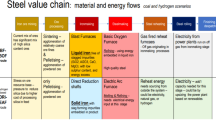Global steel production is based on the refining of liquid pig iron in basic oxygen converters. No technologies that do not use liquid pig iron are expected to replace this method in the coming decades, and ore and coal will remain the main raw materials used to make pig iron. Existing technologies that produce liquid pig iron outside the blast furnace are considerably inferior to blast-furnace smelting with respect to productivity and integral total fuel consumption, which includes the fuel costs incurred to produce coke, agglomerated ore-bearing materials, hot blast air, and oxygen. The blast-furnace process is also the leading technology in terms of the scale of production and has the lowest production costs. Not only will the blast furnace retain its lead for the foreseeable future, but there may also be significant reductions in its energy costs and environmental impacts. These improvements might come about as a result of the use of “self-reducing” ore-carbon briquettes made from concentrate and inexpensive carbon-bearing materials. It might also be possible to further intensify the smelting operation through the use of oxygen and increases in top-gas pressure.
Similar content being viewed by others
References
Shou-Rong Zhang, “The trends of ironmaking industry and challenges to Chinese blast furnace ironmaking in the 21st century,” in: Proc. 5th Int. Congr. on the Science and Technology of Ironmaking, Oct. 20–22, 2009, Shanghai, China, Vol. 1, pp. 1–13.
H. B. Luengen, M. Peters, and P. Schmoele, “The production of iron: a changing path,” Chern. Met., Sept., 18–25 (2011).
P. Schmoele, B. Korthas, and H. B. Luengen, “Hot metal production in blast furnace – potentials to reduce CO2 emissions,” Proc. METEC InsteelCon 2011, June 27 – July 1, Dusseldorf.
A. K. Tarakanov, V. P. Ivashchenko, Yu. S. Paniotov, and S. V. Bobrovitskii, “Prospects for the commercial use of liquid-phase reduction processes,” Metallurg. Gornorud. Prom., No. 4, 9–12 (2011).
W.-K. Lu, X. (J.) Jiang, and Y. Jialong, “Smelting reduction and direct reduction for alternative ironmaking,” in: Proc. 5th Int. Congr. on the Science and Technology of Ironmaking, Oct. 20–22, 2009, Shanghai, China, Vol. 1, pp. 79–86.
M. Geerdes, R. van Laar, and R. Vaynshteyn, “Low-cost hot metal: Future of blast furnace ironmaking,” Iron Steel Technol., March, 51–56 (2011).
I. E. Sperkach and I. F. Kurunov, “Reserves for intensifying blast-furnace smelting,” Metallurg, No. 2, 33–38 (2005).
I. F. Kurunov, E. M. Shcheglov, A. I. Kononov, and O. G. Bolshakova, “Study of the metallurgical properties of briquettes of technogenic and natural raw materials and assessment of their effectiveness in blast-furnace smelting. Part 1,” Chern. Metall.: Byul. NTiEI, No. 12, 39–48 (2007).
I. F. Kurunov, E. M. Shcheglov, V. L. Emelyanov, and O. G. Bolshakova, “Study of the metallurgical properties of briquettes of technogenic and natural raw materials and assessment of their effectiveness in blast-furnace smelting. Part 2,” ibid., No. 1, 8–16 (2008).
R. B. Steele, “Extrusion dies for agglomeration,” Proc. Options for Agglomeration of Inorganic Bulk Materials via Extrusion, Sept. 2009, San Antonio, Texas, Inst. for Briquetting and Agglomeration.
R. B. Steele and A. Bizhanov, “Stiff extrusion agglomeration of arc furnace dust and ore fines for recovery at a ferro alloy smelter,” Proc. 32nd Biennial Conf., Sept. 2011, New Orleans, Louisiana, Inst. for Briquetting and Agglomeration, Vol. 32.
I. K. Dalmia, I. F. Kurunov, R. B. Steele, and A. M. Bizhanov, “Production of a new generation of briquettes and their use in blast-furnace smelting,” Metallurg, No. 3, 39–41 (2012).
Wanren Xu, Yanling Guo, and Chen Wang, “Factors affecting fuel rate in COREX process and improving measures,” Proc. METEC InSteelCon 2011, June 27 – July 1, Dusseldorf.
C. Bohm, H. Heckmann, and W. Grill, “SWAI smelting/direct-reduction technology,” ibid.
Yi Sang-Ho, Joo Sanghoon, Lee Ho-Chang, et al., “An update on the technological leap in FINEX process,” ibid.
N. Goodman and R. Dry, “Hismelt plant ramp-up,” in: Proc. 5th Int. Congr. on the Science and Technology of Ironmaking, Oct. 20–22, 2009, Shanghai, China, Vol. II, pp. 1228–1233.
Author information
Authors and Affiliations
Corresponding author
Additional information
Translated from Metallurg, No. 4, pp. 40–44, April, 2012.
Rights and permissions
About this article
Cite this article
Kurunov, I.F. The blast-furnace process – is there any alternative?. Metallurgist 56, 241–246 (2012). https://doi.org/10.1007/s11015-012-9566-z
Received:
Published:
Issue Date:
DOI: https://doi.org/10.1007/s11015-012-9566-z




